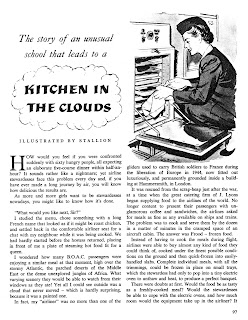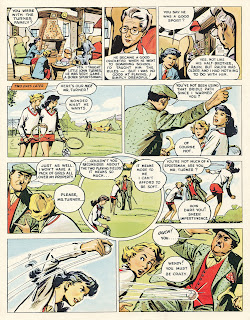British Girls' Comics: Girl - Pioneer of a New Trend
2:49 AM |
Labels:
air hostess,
Belle of the Ballet,
British girls' comics,
fashion model,
Girl,
Hulton Press,
John Ryan,
Nurse Susan marsh,
nurses,
Peter Kay,
Stanley Houghton
Girl, published by Hulton Press, was a powerful trendsetter in 1950s Britain. Sister paper to the famous boys' comic, Eagle, it served readers up a rich diet of career girl heroines, middle class culture, and private school antics. This was the world of ballerinas, horse riding, and yachts. The domain of mystery stories and adventures, and careers as a nurse, model, or air hostess. At 176 pages, Girl Annual 6 (1957) was packed with text stories, instructions for making things like lamp shades, news on the Royal Family, and tips for all sorts of everyday necessities for the upward aspiring. I like that a lot of the comic stories and art are credited - alas, something rare in older British comics. So here's a selection, starting with Belle of the Ballet, one of the longest running features in Girl. The ballerina represents almost pure fantasy for the reader, in terms of a connection to real life possibilities, and while girls could go to ballet lessons, their chances of turning this into a career at some point were extremely remote, given the limited numbers of openings for ballet dancers in the job market. In this issue Belle is drawn by Stanley Houghton:
Next, another long-running feature in the weekly comic, Nurse Susan Marsh, drawn by Peter Kay. Susan is dedicated to her job, which is made unnecessarily difficult by the bullying of Staff Nurse Fisher. In the weekly comics, Susan's adventures in nursing were dished up in small installments, the whole story perhaps running for months. In the annuals the reader was given more pages than the usual two in the weekly comic, but a shorter story overall, complete for the big book. This particular story here is a multicultural effort. I noticed that the British girls comics of the 50s and 60s tended to contain some stories, text or comic, that had British girls or women interacting in a friendly way with females of color from different parts of the world, usually corners of the British Commonwealth, but in this case a Japanese woman. It is necessary to overlook the slightly patronizing tone, and the characterization involving the broken English, but for the times this was a fairly respectful rendition:
Next let's look at this two-page illustrated text feature about the life of an air hostess. It's clearly no accident that representatives of certain careers appear in comics for girls in this period. Think Marvel's career girl funnies of the 40s and 50s - Nellie the Nurse, Millie the Model, Tessie the Typist, or some of the romance comics of the early to mid-60s featuring nurses (Young Love), air hostesses (Bonnie Taylor in Young Romance), or Hollywood starlets. There were certain stereotypes of professional women that contributed to these stock images that offered girls role models:
Indeed, what about a career in modeling?
Now here's one of those adventures reserved for the well-to-do. You need a bit of money to be able to attend private school and go horse riding in your free time. The problem in this story is that some absolute cad is trying to withdraw the sports facilities used by the school. Although a girl, Wendy has an all-round education that includes knowledge of gender segregated sports for men, specifically cricket. Thus she is able to outwit that rotter whose greed seeks to spoil their fun!
Here's another short story that illustrates that it pays to be middle class if you want an adventurous life.This time you have to have had parents who could afford to give you yachting experience, either directly with the family's own boat, or through extra-curricular activities at your private school. In this story drawn by Charles Paine, the three heroines are a dab hand at handling a sailing craft, without which their vacation could well have been quite dull:
A weekly feature in Girl comic was a cartoon strip entitled Lettice Leefe, about the zany goings on in the life of a somewhat eccentric young female. There are two pages of this Girl Annual 6 given over to Lettice:
Girl is quite a varied salad, and I've only given a brief introduction here. The text items expand the scope of the book, but I'm really just focusing on the comics. As a final example from this annual, here's a true life story of one of the greatest figures in British history, the Celtic Queen Boudicca (Boadicea), whose memory is preserved by a truly powerful, regal statue on the Thames Embankment in London:
So there you have an introduction to the most prominent British comic for girls in the 1950s and into the early 60s. Readers may be interested in this excellent article by Dr. Mel Gibson (coincidence, huh!?) of Sunderland University, which gives a really insightful introduction to the study of British girls' comics:
http://www.shef.ac.uk/content/1/c6/05/05/23/mel_gibson.pdf
Subscribe to:
Post Comments (Atom)





































0 comments:
Post a Comment